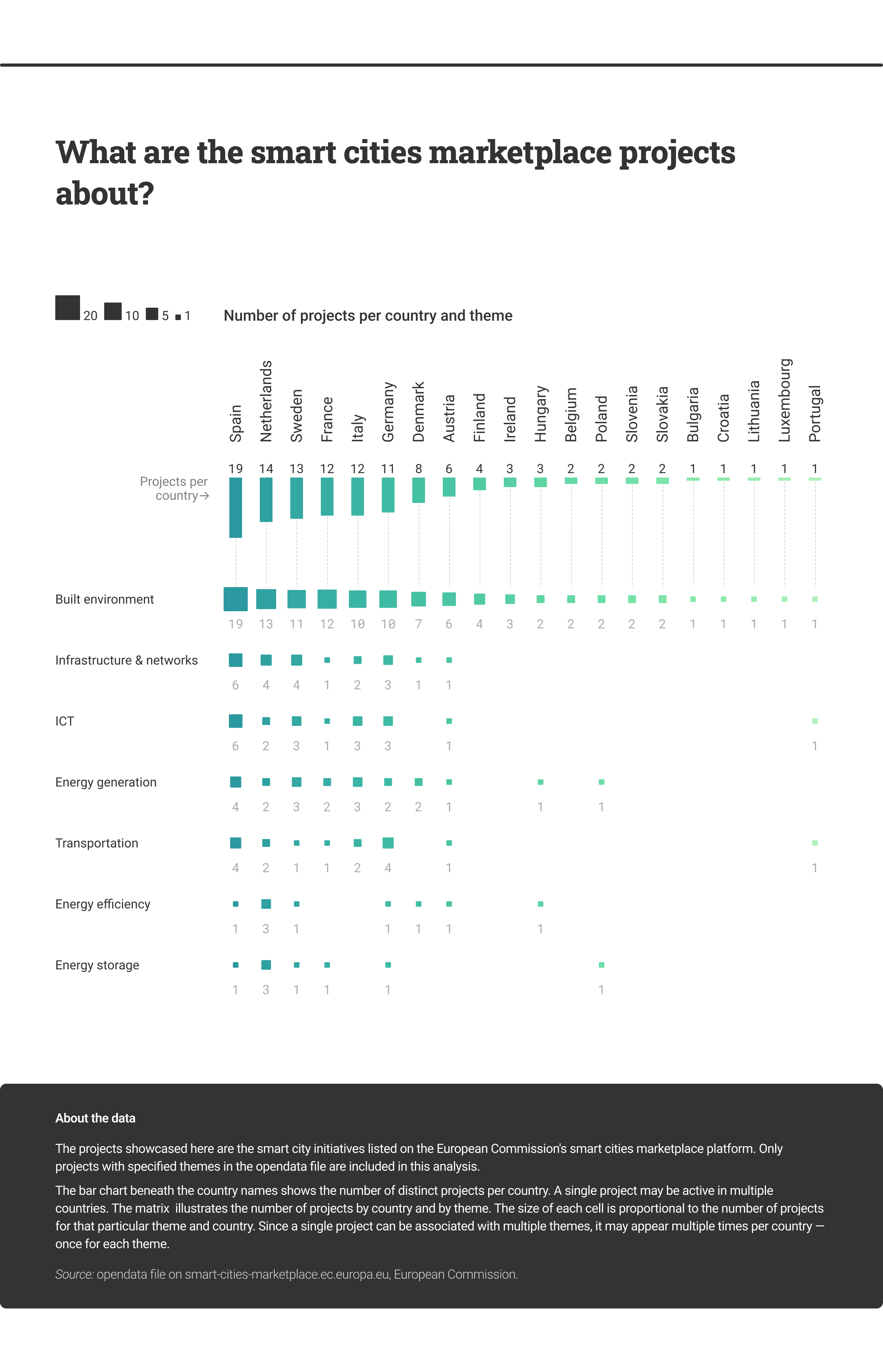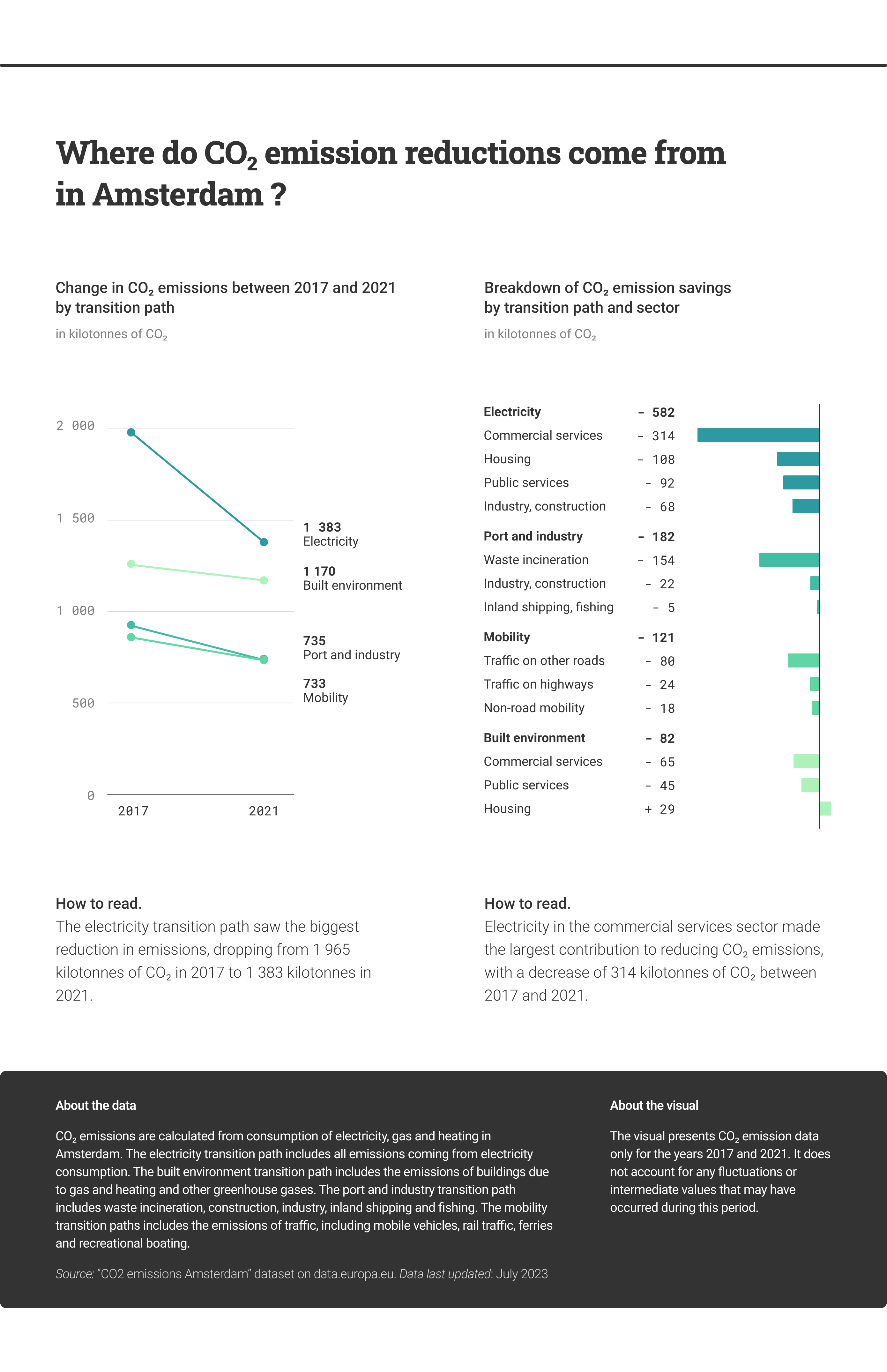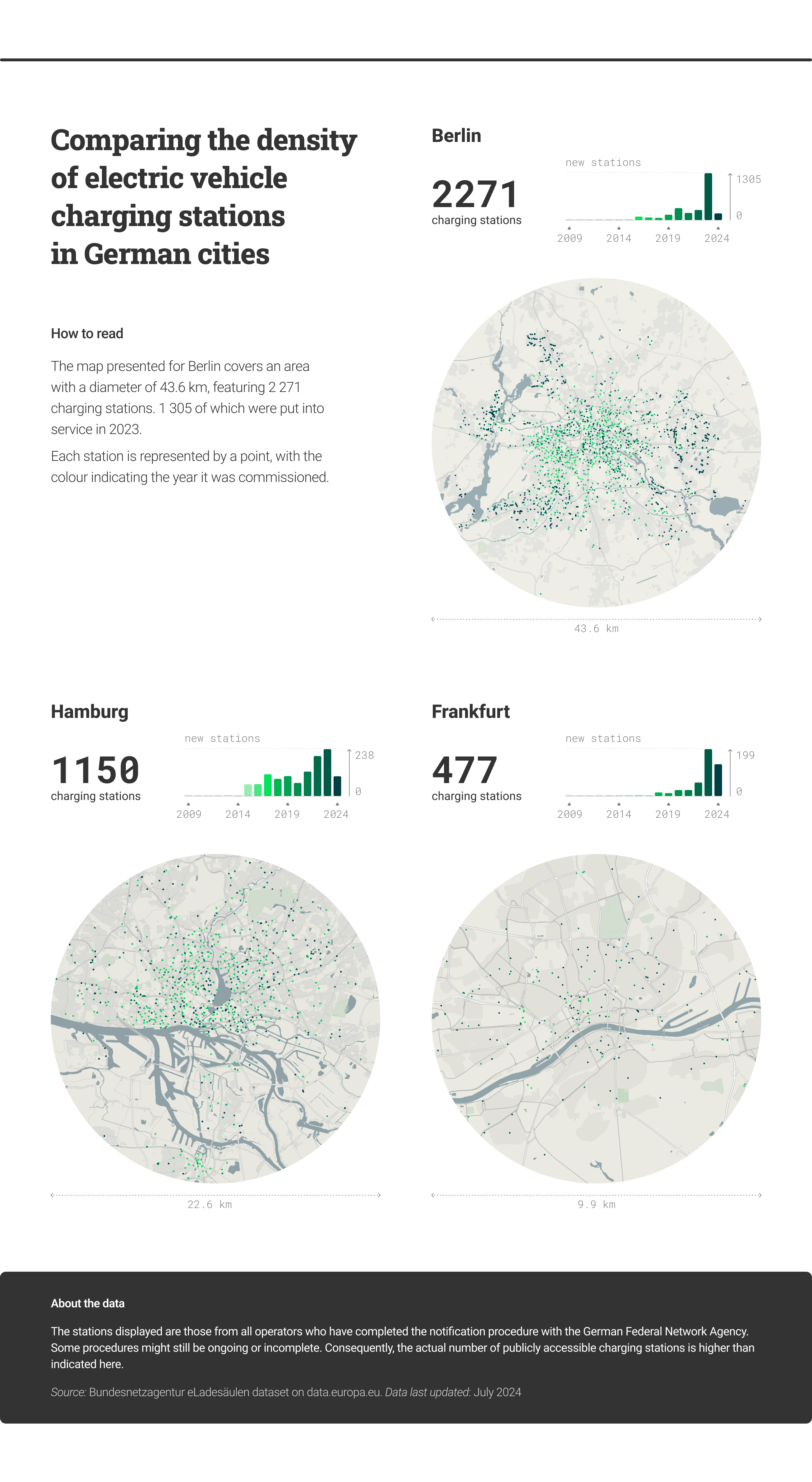Exploring the Evolution of Smart Cities Through Open Data
Looking at European cities’ investment into a sustainable and green urban future with high-value datasets
With a commitment to sustainable and greener urban development, European cities are embracing smart city initiatives. These initiatives aim to make urban areas more efficient, environmentally friendly, and inclusive.
A smart city integrates digital technology to enhance traditional services and infrastructure, creating more efficient, liveable and business-friendly urban environments.
This data story builds on our previous feature on high-value datasets, with a particular focus on mobility – a key category within high-value datasets. The story demonstrates how open data can empower cities to drive transformative change, and is organised into three main sections: (1) ‘smart cities marketplace’ covering initiatives that highlight real-world applications of smart-city technologies, (2) ‘smart cities in the energy sector’ examining energy-related smart initiatives and (3) ‘smart cities in the mobility sector’ covering mobility-related smart initiatives. Each section features a concrete use case.
Open data for smart cities marketplace
The smart cities marketplace is an initiative by the European Commission aimed at supporting and accelerating smart city developments across the EU. It encourages cities to create sustainable urban environments while offering resources to explore innovative solutions. The respective dataset (see Figure 1) highlights a selection of 54 successful initiatives implemented in 113 cities, including major urban centres such as Barcelona and Vienna. It is important to note that only projects with a defined theme are included in this selection. Additionally, a single project may address multiple themes or be applicable across several EU Member States. The visualisation provides insight into the primary themes of these initiatives, with the ‘built environment’ theme being the most prominent, followed by projects related to ‘infrastructure and networks’.
A standout example of these projects is the smart lighting from Italy, which employs geospatial data to optimise urban lighting systems. In Milan, researchers used geographic information system data to analyse street lighting and its correlation with road accidents. The study found that poorly lit areas had higher rates of night-time accidents. By mapping these problem areas, the city was able to prioritise lighting upgrades, improving public safety while enhancing energy efficiency and reducing maintenance costs. This data-driven approach ensures that urban lighting investments are targeted where they have the greatest impact.
If you are interested in exploring more details about European smart city projects, you can do so here.

Figure 1: Overview of smart cities marketplace’s projects
Source: Open data file, Smart cities marketplace, European Commission.
Open data for energy in smart cities
Urban areas, with their dense populations and high demand for services, are major consumers of energy and significant contributors to greenhouse gas emissions. Smart cities are at the forefront of efforts to transition to clean energy. Among these efforts is the NetZeroCities initiative, which involves 112 EU cities committed to achieving climate neutrality by 2030 as part of the broader EU missions smart cities programme.
A prominent example of a city participating in the NetZeroCities initiative is Amsterdam, a city that has made substantial progress toward its goal of becoming climate-neutral by 2050. The 2050 Amsterdam climate-neutral roadmap outlines a comprehensive plan for reducing carbon dioxide (CO2) emissions across various sectors. The city’s achievements are particularly evident in the energy sector, where investments in renewable energy have led to substantial reductions in emissions.
As illustrated in Figure 2, Amsterdam’s CO2 emissions from electricity have dropped from 1 965 kilotonnes in 2017 to 1 363 kilotonnes in 2021. Within this sector, commercial services have played a major role, reducing emissions by 314 kilotonnes between 2017 and 2021. Only the emissions from the housing sector have increased, likely due to Amsterdam’s population growth of 5 % between 2018 and 2023, which increased the demand for energy and drove new housing developments.
Other cities are also making notable strides in their energy transition. Barcelona, for instance, through its city-wide energy strategy, has focused on increasing the use of renewable energy and enhancing energy efficiency across its infrastructure. Copenhagen, with its smart energy systems, is another example. The city has been leveraging data since 2013 to optimise energy consumption and integrate renewable energy sources into the grid.
For more detailed insights into these and other energy scenarios, click here.

Figure 2: CO2 emission reduction in Amsterdam
Source: data.europa.eu, ‘CO2 emissions Amsterdam’ dataset.
Open data for mobility in smart cities
Transport systems in smart cities are undergoing a major transformation, transitioning toward sustainable smart mobility. This shift leverages technology to create environmentally friendly and efficient transportation networks, which are crucial for achieving the EU’s ambitious goal of reducing emissions by 90 % by 2050 as part of the European Green Deal and smart mobility agenda. A key strategy in meeting these targets is the widespread adoption of electric vehicles. Such vehicles can play a central role in reducing emissions from the transport sector, but their overall impact depends on the energy mix used to generate electricity. With the current EU energy mix and over the entire vehicle life cycle, the greenhouse gas emissions of electric vehicles are about 17–30 % lower than the emissions of petrol and diesel cars. Moreover, as the carbon intensity of the EU energy mix is projected to decrease, the life cycle emissions of a typical electric vehicle could be cut by at least 73 % by 2050.
Growth in electric vehicle usage is closely tied to the development of supporting infrastructure, particularly charging stations. Germany is leading the way in electric vehicle adoption across the EU, boasting the highest number of registered electric vehicles in 2023. This growth in electric vehicle use is supported by the rapid expansion of charging stations in German cities.
Figure 3 highlights the density of charging stations for electric vehicles in Berlin, Frankfurt and Hamburg, illustrating the development of smart mobility infrastructure in these cities. Berlin stands out with 2 271 charging stations spread across a 43.6 km diameter. The city saw a remarkable surge in 2023, adding 1 305 new stations in that year alone. Frankfurt also experienced growth, with 199 new charging stations added in 2023, reflecting its commitment to expanding infrastructure for electric vehicles. Hamburg, although showing more gradual growth, has seen a consistent increase in charging stations. Starting in 2015, the city saw notable expansions in 2022 (190 new stations) and 2023 (238 new stations), reflecting steady development in its infrastructure for electric vehicles.
For those interested in further exploring Germany’s smart mobility developments, click here.

Figure 3: Germany’s electric vehicle charging stations in three smart cities
Source: data.europa.eu, ‘Bundesnetzagentur eLadesäulen’ dataset.
Conclusion
Open data plays a pivotal role in advancing the development of smart cities across the EU, fostering greener, more sustainable and technologically advanced urban environments. The three visualisations in this data story illustrate the transformative impact of open data in driving smart city innovations. The first visualisation demonstrated the broad range of projects supported by the smart cities marketplace initiative across Europe. The second highlighted Amsterdam’s progress in reducing CO2 emissions as part of its roadmap to become climate-neutral. The third showcased the distribution of electric-vehicle charging stations in German cities, emphasising how mobility datasets support the development of sustainable transportation systems.
By continuing to leverage open data, we can accelerate progress, enhance the quality of life for citizens and contribute to the development of cleaner, smarter cities. Explore the datasets available on data.europa.eu to be part of this journey. Stay informed about the latest developments by subscribing to our newsletter and following data.europa.eu on social media.
